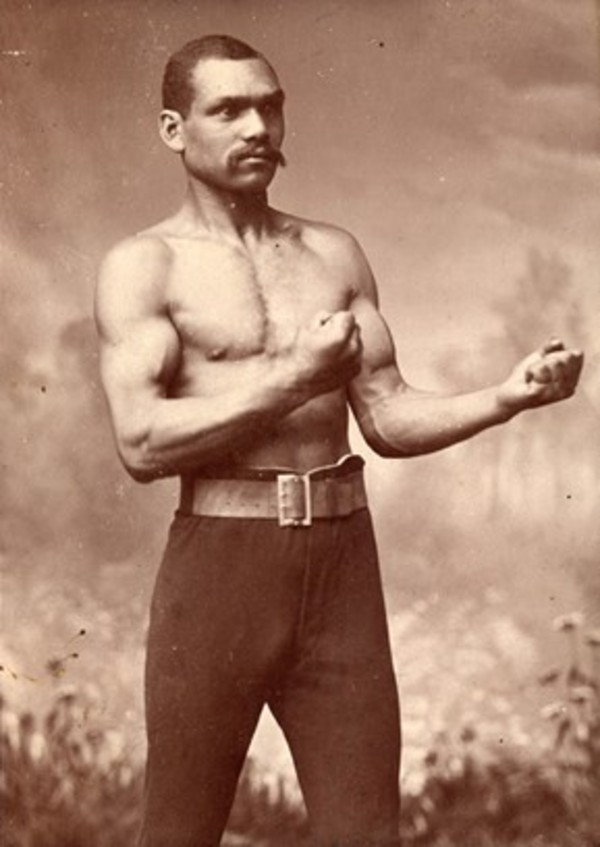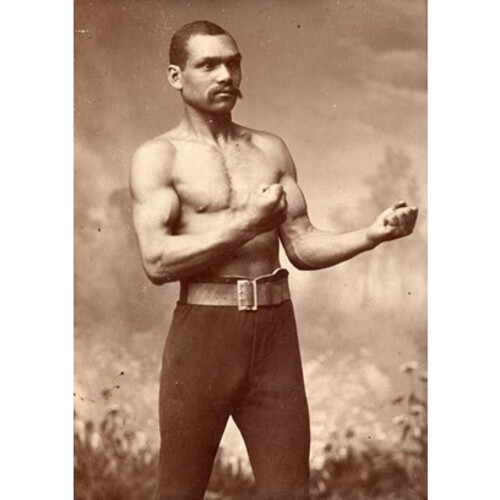
Source: Courtesy of Wikimedia Commons
GODFREY, GEORGE (Old Chocolate), boxer; b. March 1852 in Charlottetown, son of William Godfrey, a labourer, and Sarah Byers; m. in the United States and had six children; d. 17 Oct. 1901 in Revere, Mass.
George Godfrey was born in the Bog, a poor part of Charlottetown’s West End. The area had a high concentration of blacks, almost all of whom were descended from slaves brought to the Island in the 1780s as a result of the American revolution. The Bog was notorious locally for its poverty and for bootlegging, prostitution, and other minor crimes. A member of his mother’s family, Peter Byers*, was hanged for theft in 1815, and the year after Godfrey was born his father was convicted of petty larceny and served two weeks in jail for stealing a cow.
Godfrey received his first boxing instruction in Charlottetown from Dick Cronin. Around 1870 Godfrey moved to Boston, where he worked as a porter. He played baseball, trained in a gymnasium, and took boxing lessons from a “Professor” Bailey. An 1879 win in the heavyweight class at a local boxing competition led to a career as a boxer. Despite being rather old to begin prize-fighting (he was then 27) and somewhat light for his division (at 5 feet 10 ½ inches he weighed only 175 pounds), he went on to become the “first U. S. colored heavyweight champion” boxer and one of the leading fighters in the world.
Beginning in 1880, Godfrey, under the name Old Chocolate, fought an estimated one hundred bouts across the United States in the next 16 years. The origin of his professional nickname is difficult to fathom because he was not especially aged and was fairly light-skinned. A similar ring name, Little Chocolate, was given to George Dixon, a contemporary black boxer from Halifax.
Boxing was then largely segregated by race, and although Godfrey fought many of the top black and white heavyweights of his era he was denied the opportunity to cross what contemporaries called the “colour-line” and contend for a championship outside his race. For years he challenged the white boxer John Lawrence Sullivan to fight him but Sullivan, despite claiming he would do so any time the money to be won was sufficient, consistently refused to fight Godfrey or any other black. None the less, Godfrey gained notoriety from a story that an attempt to match him with Sullivan at a private club in Boston was foiled only by the arrival of the police. Godfrey won his title as “the first American colored heavyweight champion” around 1883 and apparently held it until 24 Aug. 1888 when he was defeated in San Francisco after 19 rounds with Australia’s Peter Jackson.
Godfrey concluded his career in Baltimore, Md, with a victory on 11 Nov. 1895, but continued giving boxing exhibitions, returning to Prince Edward Island for this purpose a few years later. He also operated a gymnasium and boxing school in Boston and invested carefully in property in the area. Consistent with the temperate habits that were frequently cited as playing a role in his long and successful career, he died at his home of natural causes.
Godfrey was followed to the Boston area by several other black fighters from the Bog, notably George (Budge) Byers, a prominent turn-of-the-century middleweight and light heavyweight. Philadelphian Feab Williams, a leading black heavyweight contender and sparring partner of Jack Dempsey’s in the late 1920s, fought under the name George Godfrey, apparently in tribute to the Island-born boxer.
Mass., State Dept. of Public Health, Registry of Vital Records (Boston), Death records, 17 Oct. 1901. PARO, RG 6, Supreme Court, case papers, 1853, Queen v. William Godfrey. P.E.I. Museum, Geneal. Div., File information concerning George Godfrey. St Dunstan’s Roman Catholic Basilica (Charlottetown), RBMB, 2: 341. Daily Patriot (Charlottetown), 23 Oct. 1901: 5. Journal-Pioneer (Summerside, P.E.I.), 11 Oct. 1972: 4; 23 June 1988: 6. Directory, P.E.I., 1864. N. S. Fleischer, Black dynamite, the story of the negro in the prize ring from 1782 to 1938 (5v., New York, 1938–47), 3: 99–122. M. T. Isenberg, John L. Sullivan and his America (Urbana, Ill., and Chicago, 1988). D. K. Wiggins, “Peter Jackson and the elusive heavyweight championship: a black athlete’s struggle against the late nineteenth century color-line,” Journal of Sport Hist. (Chicago), 12 (1985): 143–68.
Cite This Article
Jim Hornby, “GODFREY, GEORGE (Old Chocolate),” in Dictionary of Canadian Biography, vol. 13, University of Toronto/Université Laval, 2003–, accessed March 28, 2025, https://www.biographi.ca/en/bio/godfrey_george_13E.html.
The citation above shows the format for footnotes and endnotes according to the Chicago manual of style (16th edition). Information to be used in other citation formats:
| Permalink: | https://www.biographi.ca/en/bio/godfrey_george_13E.html |
| Author of Article: | Jim Hornby |
| Title of Article: | GODFREY, GEORGE (Old Chocolate) |
| Publication Name: | Dictionary of Canadian Biography, vol. 13 |
| Publisher: | University of Toronto/Université Laval |
| Year of revision: | 1994 |
| Access Date: | March 28, 2025 |



